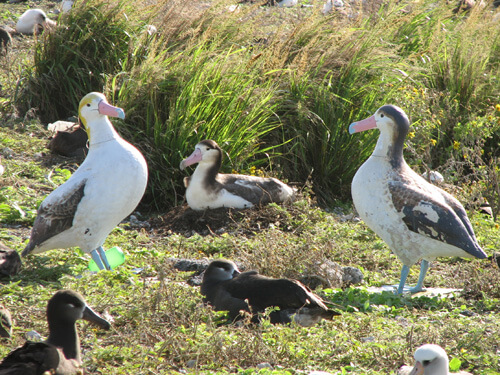Endangered Short-tailed Albatross Nests in U.S. for First Time
For Immediate Release Contact:
, 202-234-7181 ext.210
 |
Short-tailed albatross nesting (middle of image) for the first time at Midway Atoll NWR. The two decoys on either side have been used on Eastern Island for several years to attract the species. Photo: USFWS |
(Washington, D.C.,
Researchers are excited by the discovery of a Short-tailed Albatross nest containing two eggs on 213-acre Kure Atoll. Of concern, however, is that the nest is apparently being tended to by two females, which raises some doubt whether the eggs in the nest have been fertilized by a male and are viable. Researchers from Kure Atoll Conservancy were able to determine that one of the Short-tailed Albatrosses is a 17-year-old female, originally banded on Torishima Island.
On Midway Atoll, a male-female pair is incubating a freshly laid egg on Eastern Island. They have been trading off incubation duties. The adult male was banded as a fledgling on Torishima Island, Japan in 1987. The female was banded as a fledgling in 2003, also on Torishima. It is not yet known whether the egg is fertile. The nest is in a plot of model Short-tailed Albatross decoys placed to attract the species and is being monitored daily by remote video camera.
The Short-tailed Albatross was once the most abundant of the North Pacific albatross species, numbering more than a million birds. It was decimated by feather hunting at the turn of the 20th Century, and by the late 1940s was thought to be extinct. In the early 1950s, ten pairs were discovered breeding on the volcanic island of Torishima, Japan. The population has now reached 3,000 individuals, with most on Torishima, but conservationists fear an eruption there could spell disaster. For the last five years, the Short-tailed Albatross Recovery Team, an international group of collaborators, has been working on establishing a new colony on Mukojima Island, also in Japan, which is safe from volcanic activity and other problems.
“It is very encouraging to see this species begin to expand and occupy its former range and even prospect potentially new breeding locations like Kure and Midway Atolls,” said Dr. Rob Suryan, chair of the Short-tailed Albatross Recovery Team.
“Establishing another secure nesting site is one of the highest priorities for the species’ recovery,” said Dr. Jessica Hardesty Norris, Director of the Seabird Program for American Bird Conservancy, the nation’s leading bird conservation organization. “ABC hopes to see healthy breeding populations in the US in the near future, either on Kure or Midway Atoll.”
In recent years, the Short-tailed Albatross pairs have also been seen performing courtship dances on Midway Atoll, which is home to the largest nesting colonies of Black-footed and Laysan Albatrosses. ABC has been working with Midway Atoll National Wildlife Refuge and other partners to eradicate invasive weeds and restore nesting habitat there.
Outside the breeding season, the Short-tailed Albatross ranges along the coasts of eastern Russia, Korea, China, Taiwan, Aleutian and the Hawaiian Islands, and rarely off the Pacific Coast of North America south to California. Kure Atoll, which is the northern-most coral atoll in the world, consists of a six-mile wide, nearly circular barrier reef surrounding a shallow lagoon and several sand islets. The State of Hawaii and the Kure Atoll Conservancy have been trying to restore the island so that it offers even higher quality habitat for nesting seabirds. Midway Atoll also consists of a circular barrier reef and several sand islets managed as Midway Atoll National Wildlife Refuge. Midway is home to millions of seabirds as well as many historically important structures dating from World War II. Both atolls are part of the Papahānaumokuākea Marine National Monument designated by President George W. Bush in 2006.
American Bird Conservancy conserves native birds and their habitats throughout the Americas by safeguarding the rarest species, protecting and restoring habitats, and reducing threats while building capacity of the bird conservation movement. For more information, visit, www.abcbirds.org


















































